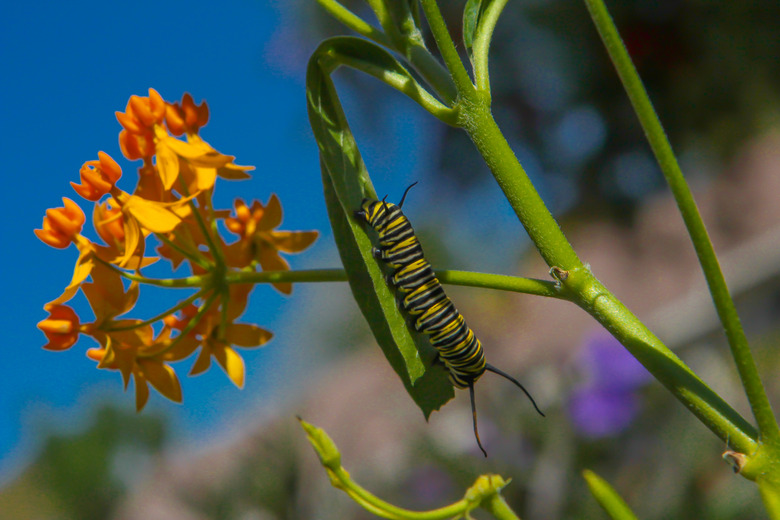How To Plant Milkweed Seeds
Whether you plant milkweed (Asclepias spp.) for the masses of flowers or the monarch butterflies, its soft, lavender-pink, yellow, orange or green flowers add a bright touch to the garden. Planting a variety of milkweed seeds ensures that you attract hordes of butterflies, bees and hummingbirds from spring to fall to your wildlife-friendly flower garden — and that you feed the striped caterpillars of the monarchs.
Prepare the Seeds
Milkweed seeds require stratification to germinate. Roll the seeds in a damp paper towel, or place them in moist peat moss, and then put them in a plastic bag. After clearly labeling the sealed bag as "milkweed seeds" and dating it, place it in a refrigerator for 10 to 12 weeks. Before planting the seeds, soak them in warm water for 24 hours to ensure that moisture breaks through their hard shells and reaches their tiny embryos.
Plant the Seeds
After stratification, plant the seeds in spring or fall. Fall plantings produce flowers the following spring and summer. Plant the seeds 1/4 inch deep and 6 to 24 inches apart in a sunny, well-drained garden bed or germinate them in seed-starting trays.
When using seed-starting trays, use moist seed-starting mix. Scatter the seeds 1/2 inch apart and 1/4 inch deep in the mix. Mist the mix thoroughly with water and cover the tray with clear, plastic material. Place the tray in a brightly lit location where temperatures remain above 70 degrees Fahrenheit. When the seedlings emerge from the mix, remove the plastic cover.
Whether planting seeds in the garden or indoors, keep the growing medium moist but not waterlogged as the seeds and seedlings develop. Transplant indoor seedlings into the garden when they are 3 to 6 inches tall.
Care for the Plants
Although most milkweed species are not fussy about soil types, having evolved in dry, open meadows, they produce more foliage and flowers in well-drained soil enriched with 2 to 3 inches of compost. After planting the seedlings, continue watering the soil until the plants are established in the garden. Then reduce watering to 1 inch per week or 6 gallons for every 1 square yard of garden.
Apply a 12-4-8, slow-release fertilizer in spring, scratching it into the soil surface around the plants at a rate of 4 tablespoons for every 4 square feet of plantings. An alternative is to apply a 24-8-16, liquid fertilizer every two months throughout the growing season, mixing it with water at a rate of 1 tablespoon per 1 gallon of water for every 10 square feet of soil.
Two to 4 inches of mulch raked over the garden bed, and pulled back 4 inches from each plant's stem, helps to reduce the evaporation of water and to maintain an even moisture level in the soil.
Support Monarch Butterflies With Milkweeds
Monarch caterpillars live only on milkweeds. Without milkweed leaves, they would starve. Planting milkweed provides habitat and food for the caterpillars and nourishes the adult butterflies before they set out on their long winter migration to the California coast and central Mexico. Twenty-five native milkweed species thrive in U.S. Department of Agriculture plant hardiness zones 3 through 9, depending on the species. Among the native milkweeds recommended by the National Wildlife Federation for monarch butterflies are butterfly weed (Asclepias tuberosa), perennial in USDA zones 4 through 9; common milkweed (Asclepias syriaca); and the moisture-loving swamp milkweed (Asclepias incarnata); common milkweed and the swamp milkweed cultivar 'Cinderella' are hardy in USDA zones 3 through 9.
Use Caution With Milkweed
Milkweed plants produce a sticky, milky sap that irritates skin and eyes. Protect your skin and especially your eyes when working with or near milkweed plants by wearing a long-sleeved shirt, long pants, closed-toe shoes, water-resistant garden gloves and safety goggles. Wash thoroughly with soap and water if you are exposed to the sap and avoid touching your eyes. If you get milkweed sap in your eyes, flush them with water and go to a medical emergency room immediately.
References
- Monarch Watch: Milkweed
- Texas A&M AgriLife Extension, Aggie Horticulture: Butterfly Weed
- Floridata: Asclepias Syriaca
- Cornell University: Growing Guide — Butterfly Weed
- Smithsonian: BugInfo — Monarch Butterflies
- National Wildlife Federation: The Monarch Butterfly — Milkweed Resources
- University of California: Safe and Poisonous Garden Plants — Toxic Plants (by Common Name)
